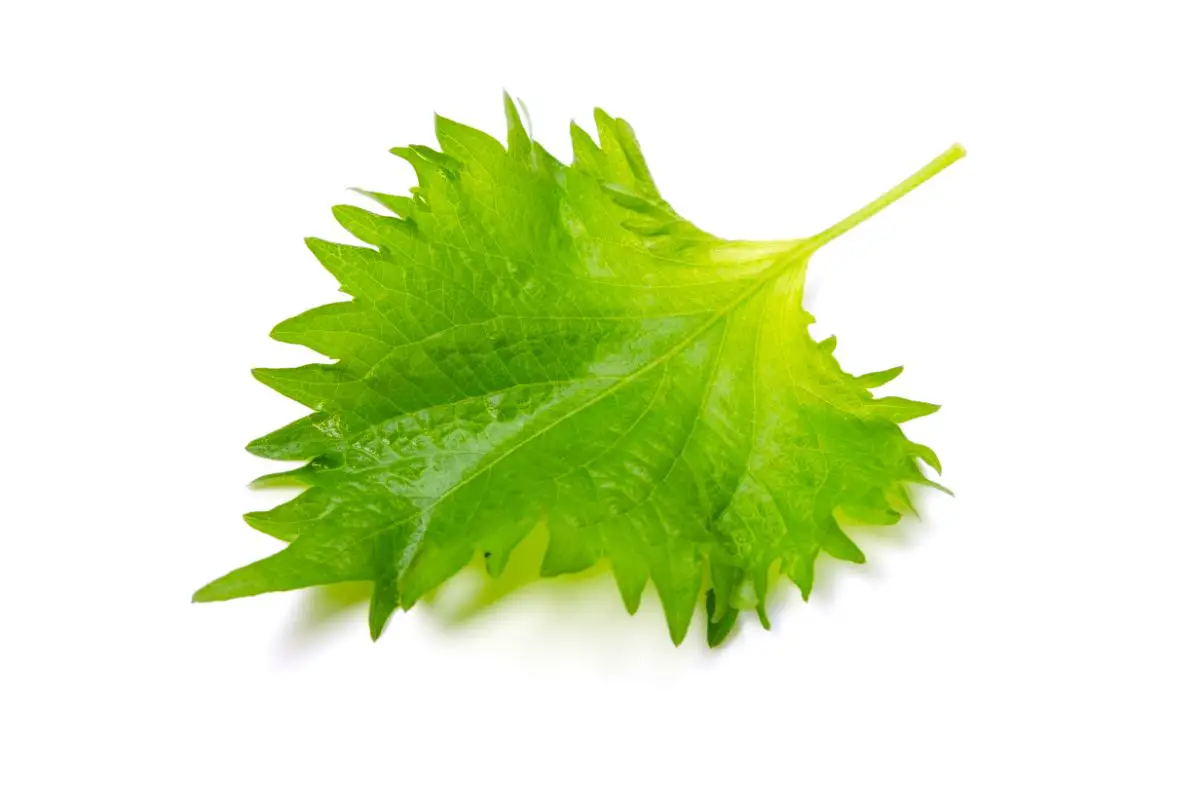Where to start with shiso? Outside of Asia, this is a little-known leaf, but shiso plays a big role in Japanese cookery.
If you’re a fan of authentic Japanese food, then you’re likely to come across shiso at some point! This leaf is eaten fresh, dried as a seasoning, pickled as a condiment, and even used as makeshift cutlery.
Despite its versatility, shiso hasn’t become as popular globally as it is in certain parts of Asia. So, when you come across shiso in a recipe, you might be wondering what it is and what you can use in its place!
In terms of flavor, mint or Thai basil are the closest substitutes for fresh shiso. But they won’t always be appropriate depending on which type of shiso the recipe calls for.
In this guide, we’ll explore all the best shiso substitutions you might need to liven up your cooking.

All About Shiso
Shiso is a member of the mint family Lamiaceae. There are two types of shiso leaf used in Japanese cookery: red shiso and green shiso. Although they both come from the same plant, they have some pretty different uses!
Red shiso leaves turn bright red when they’re steeped in umezu, a vinegar brine. This is used when pickling plums, and also to add a touch of pickled sweetness to some types of sushi.
Red shiso leaves can also be dried and made into flakes that form part of the popular yukari seasoning, sometimes known as shiso salt.
Green shiso is eaten differently! It tends to be chopped and used as a garnish on meat and noodle dishes, but it can be cooked as an herb seasoning. Shiso has a fresh taste which means it makes a good breath freshener between courses!
Green shiso leaves are also fairly large and strong, which allows them to be used as leaf wraps. They can also become makeshift cutlery — you’ll often scoop up condiments with shiso.
The 6 Best Shiso Substitutes
As you might have realized from our guide to shiso, there are many ways to use this leaf! To help you make the right replacement, we’ve listed some of the best substitutes for shiso and when to use them.
1. Fresh Mint
Shiso is a member of the mint family, and while mint isn’t a perfect substitute, it is an easily available one! Fresh mint is sold in most grocery stores, but it’s also easy to grow at home. In fact, mint has a reputation for growing a little too easily!
Use mint leaves when you want a fresh finish to foods such as meats and ramen. Mint leaves have a lightly floral note with a mild pepper kick that can be an unexpected pairing for savory meals, so be careful when adding mint.
Too much could become overpowering.
If you want to tone down the mint flavoring in your shiso, try pairing it with sweet basil. The two flavors can both be used on their own, but they make the best shiso substitute when working together.
Mint and sweet basil also have a similar appearance to shiso, which is good if you’re looking for an attractive garnish.
2. Thai Basil
Sweet basil and Thai basil are close relatives, as well as members of the same Lamiaceae family as shiso. Both basil varieties can work well as a shiso replacement, although sweet basil is best used in combination with mint.
Thai basil can be used on its own as a replacement for shiso. This is best used when you’re cooking with the leaf. Thai basil has a stronger build than sweet basil, which makes it easier to cook with as it’s less prone to disintegrating.
Use Thai basil when you need a replacement for shiso that you add early on the dish. It’s particularly good in stir-fries!
Thai basil has a complex taste. It has a touch of spice and anise, like a combination of licorice and pepper. It’s quite a powerful flavor, so be careful when adding Thai basil to your dishes.
You might need half as much Thai basil as you do shiso.
3. Scallions
Scallions aren’t the most obvious replacement for shiso leaf. For a start, they look pretty different! Scallions aren’t a leaf, and they aren’t a member of the Lamiaceae family.
Scallions are a type of onion, so they might not sound like an obvious choice when replacing shiso. However, scallions make an excellent garnish, thanks to a slight peppery taste and a more fragrant pungency than other forms of onion.
If you’re after freshness, scallion isn’t a great substitute. You could try balancing it with mint, but it would be better to use a mint and basil combination.
However, minced scallion can be a good topping for sushi, ramen, and meat dishes. You can also cook with scallions, which will help reduce pungency.
The bright green of the scallion is also useful if you plan on using shiso as an attractive garnish! A few slices of scallions will create a similar visual effect.
4. Furikake
Okay, this one might be cheating just a little, as a key ingredient of furikake is yukari aka shiso salt. If a recipe asks you to use shiso seasoning, then furikake is an excellent replacement.
Furikake is often used as seasoning for onigiri rice balls, but it’s also used as a condiment on various rice, meat, and fish dishes. Furikake combines salty flavorings with a hint of fish, a slight sweetness, and sometimes a touch of spice.
If a recipe calls for shiso seasoning, furikake does make a good replacement. However, keep in mind that furikake is a more complex seasoning than shiso.
Add it slowly and taste frequently, so you can adjust if the flavoring becomes too powerful.
5. Pickled Plums
There are limited times when pickled plums will make a good shiso replacement, but it’s still an option to know if you’re exploring Japanese cooking!
Pickled plums, also known as umeboshi, are a popular condiment in Japan, thanks to a flavor palette that combines sweet, sharp, and sour.
Pickled plums are made with red shiso leaves steeped in a vinegar brine called umezu. These pickled shiso leaves are sometimes used to make fermented or pickled foods, as well as to add a sharp tang to sushi.
If you come across a recipe asking for red shiso in umezu, pickled plums are a fantastic substitution. As with furikake, the flavor base is slightly richer, so be careful when making the substitution.
6. Grape Leaves
There’s one final method for using shiso leaves that we haven’t covered yet, and that’s as a food wrap or receptacle for condiments.
Shiso leaves are large leaves with good strength, allowing them to hold their form during the cooking process. Shiso leaves are sometimes served stuffed with delicious fillings.
Because of this strength, shiso leaves can also be used almost as a replacement for cutlery! An attractive shiso leaf will be added as a garnish for the plate, and you can use this leaf to transfer condiments from the bowl to your mouth!
When replacing shiso leaf in these circumstances, the taste is less important than the texture and consistency. That’s why grape leaves are the perfect substitution. Large and strong, a grape leaf can be used as both a wrap and a scoop.
Conclusion
We hope this guide has helped you discover more about shiso. As this is such a versatile leaf, there are many ways to use it in your cooking.
So, when it’s time to make a replacement, you want to ensure you’re making the right kind of replacement.
As a flavor replacement for fresh shiso leaf, try mint, Thai basil, or a combination of sweet basil and mint. For a salty seasoning, use furikake, or for a touch of brine tang, use pickled plums.
Scallions can work as a garnish, but grape leaves are best for wraps and cooking!
Now, let’s explore Japanese cuisine!
The 6 Best Shiso Substitutes To Liven Up Your Cooking
Course: Substitutes4
servings30
minutes40
minutes300
kcalShiso is a member of the mint family that’s popular in Japanese cuisine. Looking for the best shiso substitutes? We’ve rounded up the top options.
Ingredients
Fresh Mint
Thai Basil
Scallions
Furikake
Pickled Plums
Grape Leaves
Directions
- Decide on what substitute you need
- Pick a substitute from the list above
- Read what you need to substitute with
- Create the recipe and enjoy
Recipe Video
https://www.youtube.com/watch?v=BeSmMEhBfh0Video can’t be loaded because JavaScript is disabled: What Is Shiso? | Sushi Lessons (https://www.youtube.com/watch?v=BeSmMEhBfh0)- What Exactly Do Chickpeas Taste Like? Is There A Distinct Flavor? - September 30, 2023
- Top 11 Low Carb Options at Sonic Drive-In for Keto Diet - September 30, 2023
- What Should You Serve Alongside Potato Salad? 8 Incredible Side Dishes - September 30, 2023











